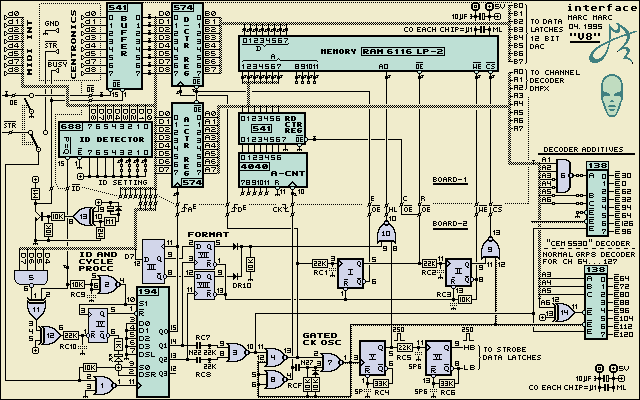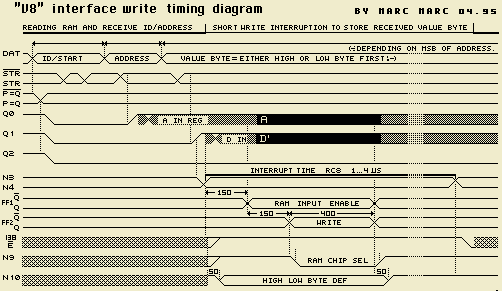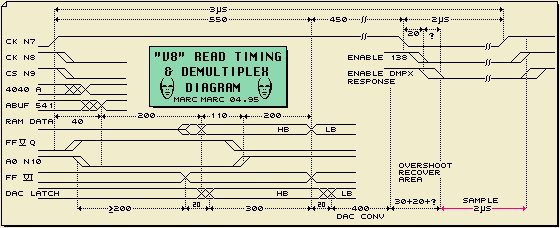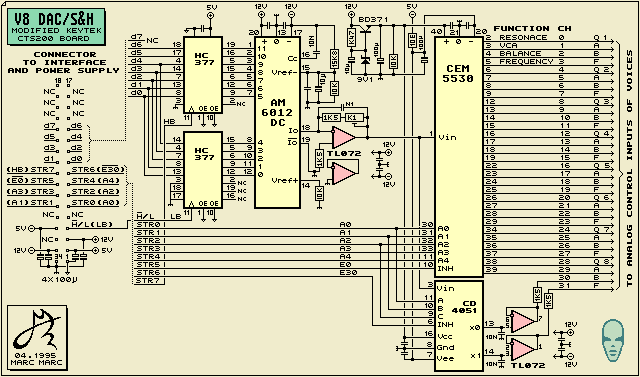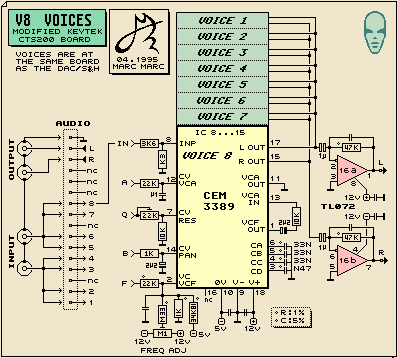Sound Mover - Marc MarcV8 Filter Unit
In 1995 the V8 computer controllable 8 channel filter unit was add to the Sound Moving Installation. By this not only moving of the sounds was possible but also, at the same time, dynamic timbre changes.
Back to Sound Mover block diagram
Like the SM132 unit, the V8 unit is MIDI controlled but also controllable by a parallel port. In practice both the SM132 and V8 unit are MIDI controlled to guarantee that both units are galvanic insulated from each other and the computer.
The explanation on the electronics are quite exhausting and even this does not give you all the details and aspects about the design. You are expected to know already about electronic principles more than a bit. Although the worksheets able you to copy the unit this does not mean that my explanation was intended to help you with this. I simply do some serious lalalala about it to stimulate designing electronics as an Art (versus manufacturer application imitation) |
. . . Data interface Other than with the SM132 the V8 has not an individual DAC for each of its 32 parameters to be controlled. Instead it uses one 12 bit DAC that is multiplexed. This implies that the analog values that are converted from the digital value need to be stored into an analog memory. This is done by a Sample and Hold circuitry for each channel. The analog memory is build up by using a capacitor as a memory element for each analog Voltage parameter of the unit (32x). This technique has the disadvantage that the capacitors are loosing their analog Voltage due to leakage and thus they need to be refreshed continuously. To do this the interface also needs a digital memory that has each binary value stored. Otherwise it should be the computer to continuously sending data to refresh the analog memories and this not convenient because the computer needs its time to execute its choreography algorithms and to transmit data changes.
|
. . . Read Cycle
Requirements The timing diagram above shows you the most important digital signals for the read cycle. When not a byte is received from the computer that need to be stored into the RAM, the interface is continuously reading data from the RAM to refresh the analog memory unit. As was explained before, it was a requirement in the design to refresh all channels of the analog memory at least one time between each byte which the computer sends. When the computer sends its bytes at full MIDI baud rate the following is true: Each byte takes 1000000/31250 baud = 32 micro seconds * 10 bits = 320 micro seconds to be transferred.
A look ahead on the results To already give you the results of the realized unit; it demultiplexes at a rate of 333KHz. This implies that within 316 micro 105 times a channel can be refreshed. This high speed is quiet unusual for a demultiplexer design (synthesizer designs that often include a multiplexed system like this, mostly demultiplex at a rate of 10 to 20Khz).
Data read from RAMReading the two bytes from RAM together forming a 12 bit binary number to be send to the DAC takes 550ns (nano seconds). This is based on a 200ns Low Power RAM (6116LP-2). The circuitry to read the RAM is dimensioned in such way that all signals are within a save time area for proper operation (think about propagation delays and RC timing tolerance). Digital to Analog conversionThe conversion time of the 12 bit DAC (AM6012) including the buffer OpAmp TL072 takes 400ns plus some overshoot recovery time. All together the analog Voltage is stable after 1 micro and the demultiplexer opens the gate for the addressed channel to refresh the Voltage over the memory capacitor. Analog memoryThe 2 micro seconds time that is available to refresh the capacitor is plenty enough to restore the loss of charge over the capacitor but is not enough to fully charge it when the Voltage needs to change extremely from its lowest (zero Volts) to its highest value (5 Volts). This however is not a problem because in that case it simply will take some extra cycles to fully charge or discharge the capacitor (and you will not notice it). The advantage of high speed demultiplexingA big problem with the demultiplexer IC's like the CD4051 of HC/HCT and also with the integrated CEM5530 are the spikes that appear when channels are switched over in the chip. Secondly the stray capacities on the board also spread the switching spikes all over the place. A big mistakes that is often made by the synthesizer designers is the lack of using the Inhibit pin of the demultiplexer to reduce crossover spikes between the channels. By using the Inhibit possibility properly one can reduce this problem already quite a bit. The demultiplexer must be inhibited before the address change on the chip and made enable again after the address is internally stable. Then the channel in the chip is switched open to charge or discharge the capacitor. When the time has come that a new analog value is about to come the chip must be inhibited again.
|
. . . DAC and S&HThe diagram below shows both the 12 bit DAC and the 32 Sample and Hold channels which store the analog voltage. DACThe two data latches (HC377) receive their data from the RAM memory from the data interface. The interface also generates a HB and LB strobe to transfer the two bytes, which appear after each other on the bus, into a 12 bit wide data register to the DAC. The DAC converts it into a current and the OpAmp converts it into a positive Voltage within the range of 0 to 5 Volts. S&H The Analog voltage from the DAC is multiplexed. On a high speed the interface reads the memory for 128 channels and send the binary values to the DAC. The Analog Voltage from the DAC then need to be demultiplexed and stored into a hold capacitor to be memorized. The CEM 5530 chip is a complete demultiplexer and S&H chip. It includes on chip hold capacitors but, it only has 30 channels. The two missing channels which are required to control the Voices are therefore build up with a CD4051 and TL072. The other channels that are read from RAM do not exist yet.
|
. . . VOICESThe CEM3389 chipThis chip, especially designed for synthesizers, has all the circuitry integrated for a Voltage Controlled 24dB low pass filter with Frequency and Resonance control, a Voltage Controlled Amplifier and a Voltage Controlled stereo output Balance stage. To make the chip operational as a Voice end stage only some components are required to interface the chip to the control voltages, to adjust the scaling and to set some initial parameters.
|
. . . Power Supply The diagram below shows the power supply for the V8 unit. It is a straight forward design with the popular 78xx and 79xx regulators. The supply delivers 3 regulated voltages for both the positive and negative supply.
|
|
For response see This page and all contents: (C)1996 by Marc Marc Amsterdam |
